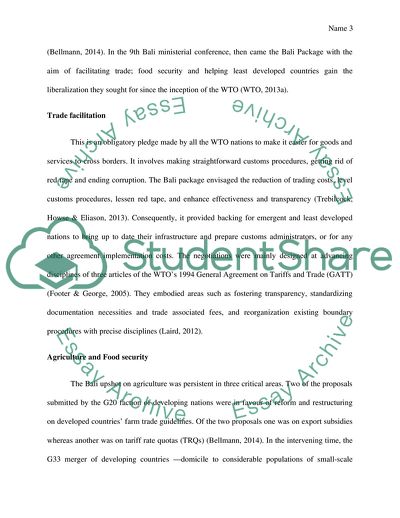Cite this document
(World Trade Organisation Agreement Report Example | Topics and Well Written Essays - 2000 words, n.d.)
World Trade Organisation Agreement Report Example | Topics and Well Written Essays - 2000 words. https://studentshare.org/law/1853757-the-adoption-of-the-bali-agreement-in-december-2013-was-only-a-modest-development-towards-the-liberalization-of-world-trade-the-wto-doha-round-of-negotiations-has-so-far-failed-to-reform-wto-law-for-further-liberalization-of-trade-in-agricultural-prod
World Trade Organisation Agreement Report Example | Topics and Well Written Essays - 2000 words. https://studentshare.org/law/1853757-the-adoption-of-the-bali-agreement-in-december-2013-was-only-a-modest-development-towards-the-liberalization-of-world-trade-the-wto-doha-round-of-negotiations-has-so-far-failed-to-reform-wto-law-for-further-liberalization-of-trade-in-agricultural-prod
(World Trade Organisation Agreement Report Example | Topics and Well Written Essays - 2000 Words)
World Trade Organisation Agreement Report Example | Topics and Well Written Essays - 2000 Words. https://studentshare.org/law/1853757-the-adoption-of-the-bali-agreement-in-december-2013-was-only-a-modest-development-towards-the-liberalization-of-world-trade-the-wto-doha-round-of-negotiations-has-so-far-failed-to-reform-wto-law-for-further-liberalization-of-trade-in-agricultural-prod.
World Trade Organisation Agreement Report Example | Topics and Well Written Essays - 2000 Words. https://studentshare.org/law/1853757-the-adoption-of-the-bali-agreement-in-december-2013-was-only-a-modest-development-towards-the-liberalization-of-world-trade-the-wto-doha-round-of-negotiations-has-so-far-failed-to-reform-wto-law-for-further-liberalization-of-trade-in-agricultural-prod.
“World Trade Organisation Agreement Report Example | Topics and Well Written Essays - 2000 Words”. https://studentshare.org/law/1853757-the-adoption-of-the-bali-agreement-in-december-2013-was-only-a-modest-development-towards-the-liberalization-of-world-trade-the-wto-doha-round-of-negotiations-has-so-far-failed-to-reform-wto-law-for-further-liberalization-of-trade-in-agricultural-prod.


